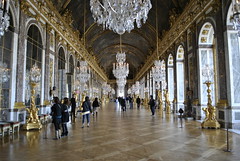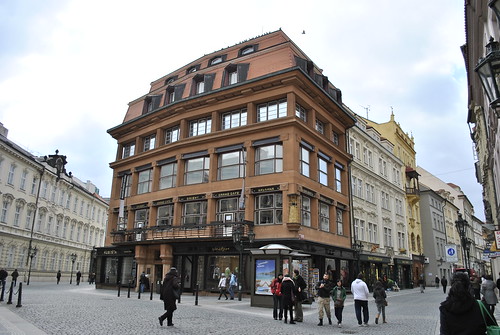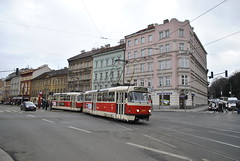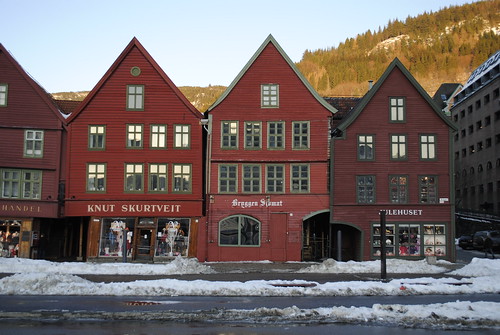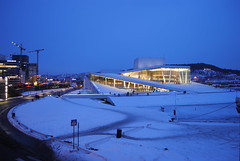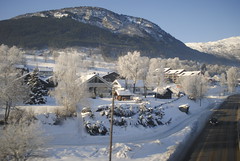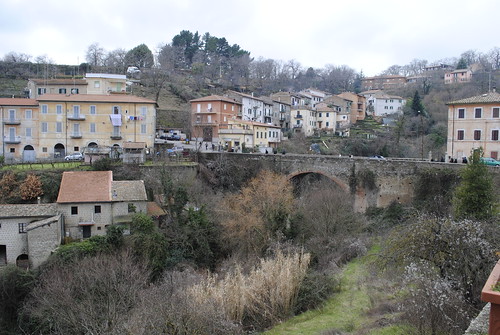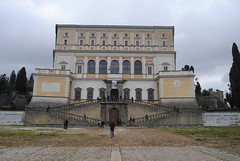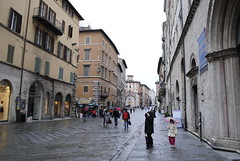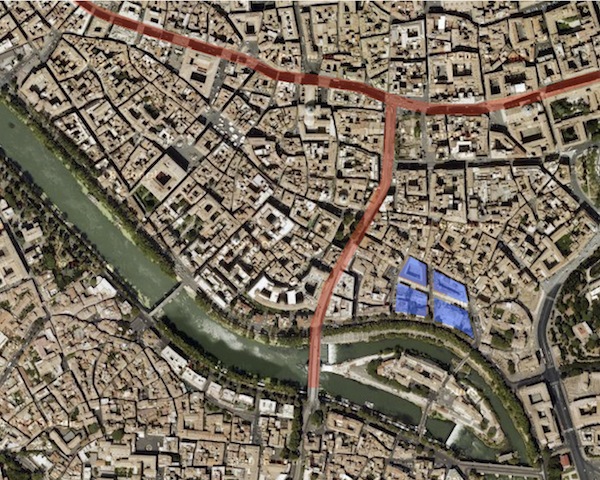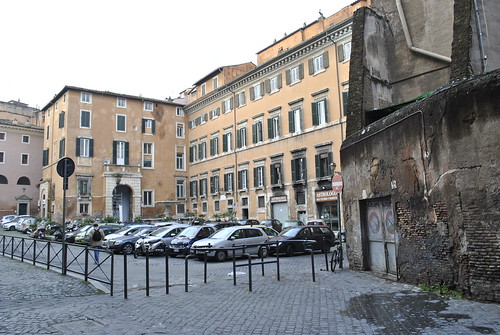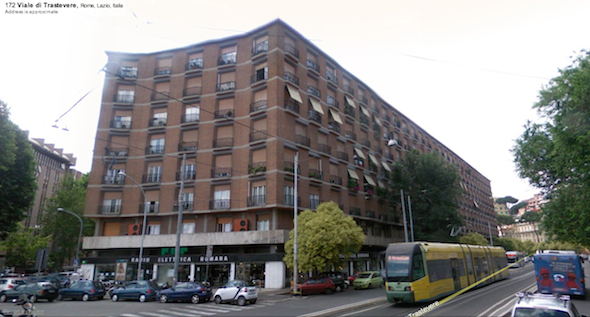Three weeks ago (March 8-13) we took a class trip to the Veneto region (province) in northern Italy. The studio was split into two groups, the other going south to Sicily. Ours was a bit smaller with only 21 students, so it was pretty relaxing and generally laid back. The weather was colder than the previous week including some snow, but our first day on Monday (March 8 ) was actually quite nice, clear and sunny.
We arrived at Venice Marco Polo Airport midmorning and met our bus. We stopped at an Autogrill for a quick breakfast and proceeded to our first stop at Carlo Scarpa‘s Brion Cemetery. Scarpa designed an L-shape addition that surrounds the existing rural cemetery for Giuseppe Brion and his wife. A nice old Italian man was there to show us in. The predominant material used was concrete, along with metal, wood, and mosaic highlights in a specific place. The cemetery was a beautiful and intriguing place. In a rural location sitting below hills of the Alps, the setting was serene on a gorgeous day.
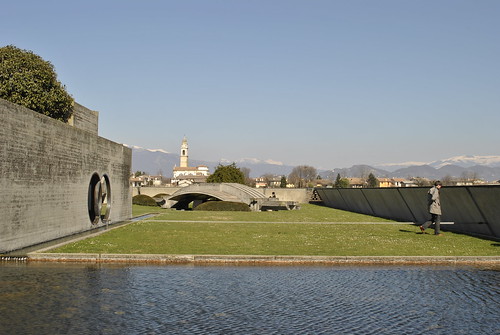
At lunch time we stopped in a town called Bassano del Grappa, that sits at the foot of the Alps. We walked from a main road into the old city center that had more than one town square before reaching the Ponte Degli Alpini, a covered wooden bridge design by Andrea Palladio in 1569. Bassano del Grappa was the first town we stopped at in Veneto, and the northern influences from Austria and Germany were evident in the architecture, culture and restaurants. My friend and I ate at a German restaurant.
Later that day we stopped at Villa Emo, by architect Andrea Palladio, built in 1559. Interestingly this villa was for agricultural purposes, so in place of elaborate gardens were instead farm fields. The villa itself is very long and slim. The back is left unfinished (just basic brick and stone) facing the fields. The interior and front loggia were decorated in frescoes. I enjoyed walking behind the villa and seeing the agriculture fields beyond, still in use.
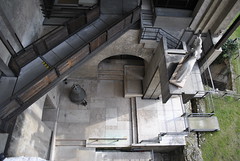 For the first two nights we stayed at a nice hotel in the city center of Verona, a good sized city. Tuesday morning we visited Museo di Castelvecchio, a castle built in the 1350s by the Della Scala family for defense against invasion and outside rebellion. It had various uses over the centuries as Verona had a number of different occupations – under Napoleon radical changes took place including the construction of army barracks. In 1925 it became a museum. In 1958, a new organization of the entire building was planned and undertaken by Carlo Scarpa. His interventions helped unify the different additions and improve navigation through the complex. The attention to detail, tectonics and material connections that Scarpa is known for clearly stood out. We spent about two hours here exploring the museum and sketching.
For the first two nights we stayed at a nice hotel in the city center of Verona, a good sized city. Tuesday morning we visited Museo di Castelvecchio, a castle built in the 1350s by the Della Scala family for defense against invasion and outside rebellion. It had various uses over the centuries as Verona had a number of different occupations – under Napoleon radical changes took place including the construction of army barracks. In 1925 it became a museum. In 1958, a new organization of the entire building was planned and undertaken by Carlo Scarpa. His interventions helped unify the different additions and improve navigation through the complex. The attention to detail, tectonics and material connections that Scarpa is known for clearly stood out. We spent about two hours here exploring the museum and sketching.
We had a little under two hours to explore the city of Verona and grab lunch before regrouping to go to Mantua. This day was much colder than Monday. In Mantua we visited Palazzo Te, a Manarist palace from the 1530s with fantastic frescos. Following we walked into the city stopping at Alberti’s Basilica di Sant’Andrea, currently under heavy renovation. Then we continued to Palazzo Ducale, an enormous complex that is now a museum. While there the snow fall began to really pick up so we returned to Verona for the night.
Wednesday was characterized by snow. We left Verona in the morning heading toward the city of Vicenza. It was a nice longer bus ride through the Berici Hills en route to our first stop at Villa da Schio. This was a much more “hands on” tour, given by a descendent of the Trento family, for which the palazzo is still in hands. Significant about it is the natural air conditioning installed using the cool air from deep quaries in the hills nearby. The caves recently have been used for growing mushrooms and making wine. We had wine tasting there with our packed lunch.
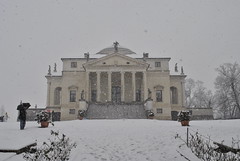 We continued to Villa Rotunda, a 16th century Renaissance summer residence designed by Palladio. Used as a party villa, the building has a centralized plan with four identical porticos. Situated 45 degrees off the north-south axis on a plateau above the surrounding land, direct light is able to reach each facade at some point during the day. While we were there the snow continued to fall and accumulate, which was actually quite a unique experience to see it with snow. Inside there were some corner side rooms, but otherwise we were only in the central rotunda space that occupied most of the building. Once outside we walked around all sides and a light-hearted snow ball fight inevitably broke out. Who else can say they’ve done that at Villa Rotunda? : ) With cold wet feet we went to Vicenza and checked into the hotel, where most people, including myself, took a nap before dinner.
We continued to Villa Rotunda, a 16th century Renaissance summer residence designed by Palladio. Used as a party villa, the building has a centralized plan with four identical porticos. Situated 45 degrees off the north-south axis on a plateau above the surrounding land, direct light is able to reach each facade at some point during the day. While we were there the snow continued to fall and accumulate, which was actually quite a unique experience to see it with snow. Inside there were some corner side rooms, but otherwise we were only in the central rotunda space that occupied most of the building. Once outside we walked around all sides and a light-hearted snow ball fight inevitably broke out. Who else can say they’ve done that at Villa Rotunda? : ) With cold wet feet we went to Vicenza and checked into the hotel, where most people, including myself, took a nap before dinner.
Thursday morning we walked in to the old city to see a number of buildings by Palladio. Of note the Basilica Palladiana, a market building constructed in the 15th century as the seat of government (called Palazzo delle Ragione) and reconstructed in the 16th century by Palladio. He added a new outer shell with a classical loggia of marble, obscuring the original Gothic architecture. Adding a new outer layer presented spatial challenges at the corners, requiring the end arches to actually be smaller. Also the new shell came extremely close to other adjacent buildings.
Also in Vecenza we visited the Teatro Olimpico, the oldest surviving enclosed theater in the world. Designed by Palladio in the 1580s to fit inside an existing old, irregularly shaped fortress. Completed by Vincentzo Scamozzi after Palladio’s death, it was based on his sketches. Included were seven permanent false perspective stage scenes (see photo) that still remain today. We stayed to sketch the theater while a tour group came through for an impressive audio-visual lighting show highlighting the various artifacts and features of the theatre.
We then took a bus to the city of Padua where we visited their Palazzo della Ragione, a civic basilica built in 1218. Claimed to have the largest roof unsupported by columns in Europe, the upper level was a massive open space now used for exhibits. Ground level is still occupied by several small market buildings and now other restaurants and businesses as well. The remainder of the day was free to explore the city. I stopped in a few different churches that were much different than the churches I’ve seen in Rome. The northern European and Venetian influence was quite noticeable.
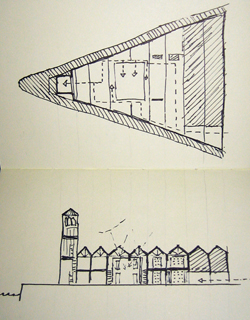 Friday morning we took a brief train ride to Venice. We spent a few hours at the Punta della Dogana museum, which is housed in the former customs house, renovations designed by Tadao Ando. The building is triangular ending at its narrowest end with a belvedere tour at the end of the pier. Inside was divided in linear rows which you wind through and around to explore the gallery. With a second level throughout much of the building, there is no prescribed linear pathway through the exhibits. Instead visitors choose their own way through. The second level was open to below in many areas so visually the entire museum was quite connected, but actually getting between levels and different exhibit areas was not as simple. At the narrowest section before the tower is the museum store with a modest cafe. The exhibits on display were pretty interesting, some particularly graphic but indeed intriguing. We had a brief discussion as a group afterwords not only about the building but the exhibits as well. See my sketch to the right.
Friday morning we took a brief train ride to Venice. We spent a few hours at the Punta della Dogana museum, which is housed in the former customs house, renovations designed by Tadao Ando. The building is triangular ending at its narrowest end with a belvedere tour at the end of the pier. Inside was divided in linear rows which you wind through and around to explore the gallery. With a second level throughout much of the building, there is no prescribed linear pathway through the exhibits. Instead visitors choose their own way through. The second level was open to below in many areas so visually the entire museum was quite connected, but actually getting between levels and different exhibit areas was not as simple. At the narrowest section before the tower is the museum store with a modest cafe. The exhibits on display were pretty interesting, some particularly graphic but indeed intriguing. We had a brief discussion as a group afterwords not only about the building but the exhibits as well. See my sketch to the right.
At lunch time I made my way over to Piazza San Marco (St. Mark’s Square – left photo below), the dominant square in Venice where St Mark’s Basilica and its associated campanile are located. About a thousand years old now, the basilica is one of the most famous examples of Byzantine architecture. I was looking forward to seeing it, being one of the select churches I specifically remembered from arch history, now four years ago. The scale of the church and certainly the piazza was much larger than I had imagined. Construction work was being done at the base of the campenile and parts of the building facades bounding the piazza were covered in scaffolding. The basilica was beautiful, but its current situation was pretty tacky with crowd barriers everywhere and a makeshift souvenier shop set up at the entrance.

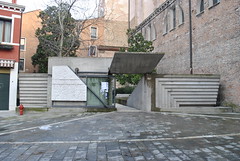
After regrouping briefly with the whole class we went to see a modest bridge designed by Carlo Scarpa. Then a small group of us took an obligatory, but nonetheless enjoyable gondola ride around the canals. Besides general exploring, a friend and I also checked out the Faculty of Architecture campus of the Universitá luav di Venezia, not far from our hotel with a Scarpa designed entrance (above right photo). We ended up walking around inside and in the library where students were working. It was interesting to see the facilities and to an extent, the work style of architecture education in Italy.
To end the trip, that evening we had a group dinner at a seafood restaurant. It was much less elaborate than the larger group dinner in Perugia, but still good. On the walk back we stopped for gelato, but it was not the best. In the morning we left early to fly back and returned to Rome by noon. It was an intense trip and we got to see a lot of different sites and visited a number of cities.
See my trip photos here.


